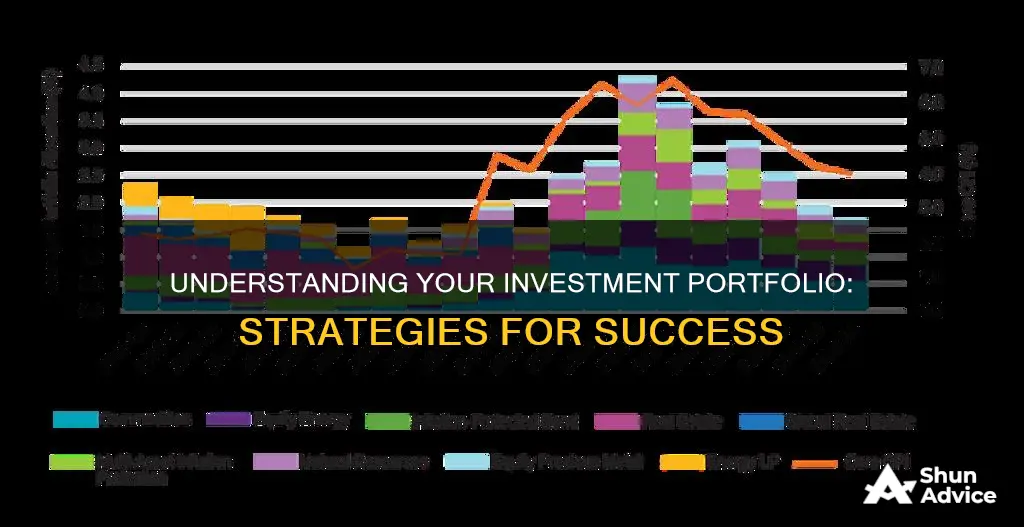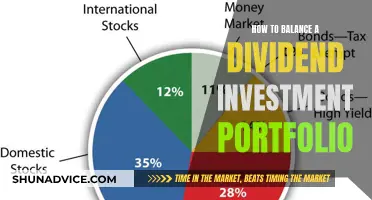
Building an investment portfolio can seem daunting, but it doesn't have to be. An investment portfolio is a collection of assets, including stocks, bonds, funds, and other financial instruments. The key to making sense of your investment portfolio is to understand your financial goals, risk tolerance, and time horizon. Here are some steps to help you make sense of your investment portfolio:
- Define your financial goals: Are you investing for retirement, saving for a down payment on a house, or funding your child's education? Each goal will have a different time horizon, and understanding this will help guide your investment strategy.
- Determine your risk tolerance: How much risk are you comfortable taking? This will depend on your emotional and financial situation. If you're nearing retirement, you may want to take on less risk, while a younger investor may be more comfortable with a higher-risk portfolio.
- Choose the right account: Select an investment account that aligns with your goals. For example, if you're investing for retirement, a tax-advantaged account like an IRA might be a good option. If you're saving for a short-term goal, a regular taxable brokerage account may be more suitable.
- Diversify your portfolio: Diversification is a key aspect of a well-constructed portfolio. Spread your investments across different asset classes, such as stocks, bonds, and cash. You can further diversify within these asset classes by investing in different sectors, company sizes, and geographic locations.
- Monitor and rebalance: Regularly review your portfolio to ensure it aligns with your goals and risk tolerance. Over time, the weightings of your investments may shift, and you may need to rebalance your portfolio to restore it to its original makeup.
- Seek professional help: If you're unsure where to start or want more personalized advice, consider consulting a financial advisor or using a robo-advisor service. They can help you build and manage a portfolio that aligns with your goals and risk tolerance.
| Characteristics | Values |
|---|---|
| Purpose | Define your financial goals, e.g. retirement, college education, general investing |
| Time horizon | Establish how long you'll be investing for each goal |
| Risk tolerance | Determine how much risk you can accept based on your emotions and financial situation |
| Liquidity needs | Assess if you need to draw on investments to meet regular expenses |
| Asset allocation | Decide on the mix of stocks, bonds, cash and other investment types |
| Diversification | Spread investments across different types of assets and sectors |
| Taxes | Consider tax implications of different investment types |
| Monitoring | Regularly review your portfolio to ensure it aligns with your goals and risk tolerance |
| Rebalancing | Periodically adjust your portfolio to restore its original makeup |
What You'll Learn

Define your financial goals
Before you start investing, it's important to define your financial goals. This will help you determine how much you need to put away, what level of risk you should take, and what investments you choose. Ask yourself: What am I trying to achieve?
Your financial goals are the ''why'' of investing. Make a list of your long-term objectives, such as paying for retirement, a home, or education. Next, think about your time horizon: When will you need the money for those goals?
Your risk tolerance is another major factor in determining your financial goals. All investing involves some risk, but how much feels right for you based on your emotions and financial situation? If you're investing for the long term, you may be able to take on more risk, as you'll have more time to recover from any potential losses. On the other hand, if you're investing for a shorter-term goal, you may want to take on less risk to preserve your capital.
It's also important to consider your cash or liquidity needs. Do you anticipate needing to draw on your investments to meet regular expenses or upcoming large purchases? This will impact how much you need to invest and how soon you'll need to access your funds.
Finally, take the time to calculate how much you'll need to invest to reach your goals. This will depend on your timeline and the amount you're aiming for. There are many online calculators available to help you with this step.
Flat Fee Investment Management: Understanding the Basics
You may want to see also

Allocate assets
Allocating assets is possibly the most important investment decision you will make. Your asset allocation will likely have a greater impact on your portfolio's risk and return than the individual investments you select.
Your asset allocation is your portfolio's basic investment mix of individual stocks and bonds, mutual funds, exchange-traded funds (ETFs), and perhaps smaller stakes in other investments and cash.
Your portfolio's asset allocation should be based on your financial goals and risk tolerance. For example, if you are investing for retirement, you may have a time horizon of 20 to 30 years. If you are investing for a child's college tuition, your time horizon may be 10 to 15 years.
Your risk tolerance depends on factors such as your comfort level with fluctuations in the value of your portfolio. If you are fairly new to investing, it may be prudent to take less risk than you think you can tolerate.
Your asset allocation should also depend on your overall financial profile, including your job security, the steadiness of your income, how much debt you have, and whether you have any other assets.
- Stocks: Stocks have the potential for high returns but also carry higher risk. If you opt for individual stocks, it is usually wise to allocate only 5% to 10% of your portfolio to them.
- Bonds: Bonds are loans to companies or governments that get paid back over time with interest. They are considered safer investments than stocks but generally have lower returns. They are referred to as fixed-income investments because they offer a fixed rate of return. This can balance out the riskier investments within a portfolio.
- Mutual funds: Mutual funds allow you to invest in a basket of securities, such as stocks or bonds, all at once, adding instant diversification to your portfolio. They are generally less risky than individual stocks but have higher fees.
- Index funds and ETFs: Index funds and ETFs try to match the performance of a certain market index, such as the S&P 500. They tend to have lower fees than actively managed funds because they don't require active fund management. The main difference between the two is that ETFs can be actively traded on an exchange throughout the trading day, while index funds can only be bought and sold for the price set at the end of the trading day.
- Commodities and precious metals: These assets can add diversification to your portfolio because they sometimes outperform when stocks struggle. However, they can be notably risky and may create anxiety, especially if you focus heavily on their fluctuations rather than your portfolio's overall performance.
When allocating assets, it is important to remember that diversification is key. Your portfolio should not only be diversified across different types of assets but also within each asset class.
Global Investment Portfolio: Understanding Your Worldwide Assets
You may want to see also

Diversify your investments
Diversifying your investments is a crucial aspect of building a robust investment portfolio. Here are some detailed instructions to help you diversify effectively:
- Don't Put All Your Eggs in One Basket: The core principle of diversification is to spread your investments across different asset classes and sectors. By doing so, you reduce the risk of losing money if a particular investment or market sector underperforms. Diversification doesn't guarantee gains or eliminate losses, but it improves your chances of mitigating losses and enhancing returns.
- Asset Allocation: Determine the right mix of stocks, bonds, cash, and other investments for your portfolio. Diversification is about finding the right balance between different types of assets. Stocks typically represent the most aggressive portion of a portfolio, offering higher growth potential but also higher risk. Bonds, on the other hand, are considered more conservative and can provide a cushion against stock market volatility.
- Explore Different Investment Options: Diversify within asset classes by investing in a mix of large, medium, and small companies across various sectors. Consider investing in international stocks, exchange-traded funds (ETFs), mutual funds, real estate investment trusts (REITs), and commodity-focused funds. Each of these options provides exposure to different segments of the economy and can help protect against inflation.
- Understand Risk and Return: Diversification helps balance your comfort level with risk and your time horizon. Investing too conservatively when you're young may result in lower returns that fail to keep up with inflation. Conversely, investing too aggressively when you're older can expose your savings to market volatility, making it challenging to recoup losses. Diversification helps mitigate these risks.
- Regularly Review and Adjust Your Portfolio: As your life circumstances and financial markets evolve, periodically review and rebalance your portfolio. This may involve selling some assets that have grown in value and buying others that may offer better prospects. Remember to consider your risk tolerance and time horizon when making adjustments.
- Consider Costs and Fees: When diversifying your portfolio, be mindful of the costs involved. Some investments, like index funds, are known for their low fees, while others, such as mutual funds, may have higher fees and trading commissions. Ensure you understand what you're paying for and whether it aligns with the value you're getting.
By following these guidelines, you can effectively diversify your investments, reducing risk, and improving the potential for long-term growth and protection.
Making Exports Affordable: Investment Strategies for Trade Success
You may want to see also

Select investments
Once you have an asset allocation and diversification plan, choosing individual investments may become easier. You will know which buckets you want to fill and what your target portfolio percentage is for each.
For instance, you might have set aside 5% for emerging market stocks, so it now becomes a matter of finding the right investment for that slot in your portfolio.
For your stock bucket, you might use individual shares, mutual funds, or ETFs. If you opt for individual stocks, you will need to research each company, including its sales, profits, market share, management, and the competition within the company's industry.
If you go the mutual fund or ETF route, you will need to make another choice: whether to use actively or passively managed funds. With active funds, managers pick investments they hope will perform better than average. Passively managed funds, also known as index funds, try to match the performance of a benchmark index.
You have similar choices with bonds. You can buy individual government, corporate, or municipal bonds, or you can opt for mutual funds containing bonds, buying either an actively managed bond fund or one that mimics the performance of a benchmark index.
Wealth Management: When to Hire a Money Manager
You may want to see also

Monitor your portfolio
Once you've built your investment portfolio, it's important to monitor it regularly to ensure it stays on track with your goals and risk tolerance. Life and financial markets change frequently, so it's a good idea to review your portfolio at least once a year, and possibly more often. Here are some key considerations for monitoring your investment portfolio:
- Review your goals and circumstances: Keep track of any changes in your personal circumstances that may impact your investment strategy. This could include alterations to your risk tolerance, time horizon, or financial situation. For example, if your risk tolerance has decreased, you may need to reduce the number of equities held or adjust your asset allocation to include more conservative investments.
- Check your portfolio's performance: Evaluate the performance of your investments and assess whether they are meeting your expectations. If your investments are underperforming or not aligned with your goals, you may need to consider making changes to your portfolio.
- Rebalance your portfolio: Over time, the weightings of your investments may shift due to price movements. Rebalancing involves periodically adjusting your portfolio to return it to your desired asset allocation. For example, if you originally allocated 60% of your portfolio to stocks, but due to market fluctuations, this has increased to 65%, you may want to sell some stocks or invest in other asset classes to restore the original allocation.
- Consider tax implications: When rebalancing your portfolio, be mindful of the tax implications of selling certain assets. For example, if you have investments that have appreciated significantly, selling them may incur capital gains taxes. In such cases, you may want to explore alternative strategies, such as tax-loss harvesting, to mitigate the tax burden.
- Stay informed: Keep yourself updated on market trends, economic conditions, and industry news. This will help you make more informed decisions when monitoring and adjusting your portfolio.
- Seek professional advice: If you feel overwhelmed or unsure about monitoring your portfolio, consider consulting a financial advisor or using a robo-advisor service. They can provide guidance and recommendations based on your goals and risk tolerance.
Remember, monitoring your investment portfolio is an ongoing process, and it's important to stay proactive and adaptable to ensure your investments remain aligned with your financial objectives and risk appetite.
Where Equity Investments Hide in Financial Statements
You may want to see also







